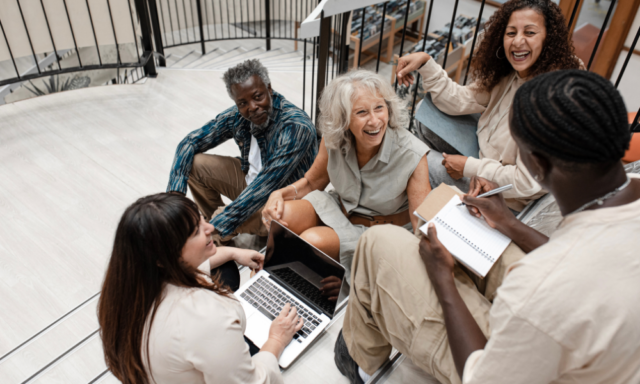
We’re at the point where older adults — ages 65 and up — are becoming one of the largest demographics in the U.S. By 2035, there will be more seniors than children under 18 for the first time in U.S. history.¹
Remember last year when the surgeon general reported that social isolation can be as harmful to health as smoking 15 cigarettes a day?² That’s sobering. Isolation can lead to all kinds of poor health outcomes like chronic illness and disease, high blood pressure, depression, weakened immune systems, etc., etc. As all the headlines have pointed out: It’s a crisis.
Recommended read: The U.S. Surgeon General’s Advisory on the Healing Effects of Social Connection and Community
And what about ageism? It’s everywhere, and it’s often subtle. Sometimes the younger crowd needs reminding: Elders are creators, innovators, and contributors. Museums can and should lead the way in changing this narrative.
Let’s take a look at recent examples of quality programming for seniors at different types of museums.
Successful Museum Programs for Older Adults
The Museum of Fine Arts in Houston used grant money from E.A. Michelson Philanthropy to launch a program called What I Know and When I Knew It. It’s a mix of storytelling and artmaking, where older adults share personal narratives and transform them into works of art for an exhibition. What a lovely way to preserve history and build empathy, and to showcase the vibrant and rich lives of older adults in the Houston community.
Everything about this next example applies, so I’ll quote from the source directly:
… Making connections is of keen interest to older adults, not only in the tracing of roots but in the increasing preoccupation we take on with matters of legacy as we age. What stories can we leave behind, we wonder. Who among us, for example, has not thought, “If I only had the opportunity to ask granddad and grandma what brought them to this country, how they met, or how fearful they were during WWII?” …
There is a stunningly simple and inexpensive way museums can help people preserve their memories: by holding writing workshops. I know from experience that they work; we have convened them in several of the museums I have directed. The formula is simple: find a conducive and hopefully inspiring setting, invite a noted author (from either your area or elsewhere) interested in teaching about their craft, advertise the opportunity, and “Bob’s your uncle!” You now have a writing workshop! (Source: Mystic Chords of Memory: Writing workshops as museum creative aging programs)
Elmhurst History Museum offers Memories Matter: Senior Recollections, 30- to 45-minute programs designed to encourage reminiscing and the sharing of lived experiences. It’s tailored to be especially valuable to those facing memory challenges. Topics include Photo Reminiscence, Toys of Yesteryear, and Hearth and Home. Toys of Yesteryear, for example, has museum staff bringing out popular toys from the 1940s through 1970s, allowing people to play with the museum’s hands-on toy collection while they chat. The Tallahassee Museum does something similar, with the added bonus of offering their hands-on Senior Programs either at the museum or off site.
Recommended read: Enhancing Lives Through Art: QAGOMA’s Art and Dementia Programme (includes best practices for this type of program)
I also like how the Carnegie Museums of Pittsburgh organize their programs in an easily searchable Just for Seniors category. Fab Lab Senior 101 Workshops at The Carnegie Science Center are designed specifically for people ages 65 and above. These workshops provide hands-on experiences with digital fabrication tech like 3D printing and laser cutting. It’s all about creating personalized projects and empowering older generations by introducing them to modern fabrication tools. Lifelong learning at it’s finest.
You will definitely want to take a look at the Denver Art Museum, which features an entire Creative Aging category in the programs section of its website. From Art at Hand, which distributes themed boxes inspired by artwork in the collection to Denver-area organizations and residential communities, to the Creative Aging Forum, a space for “individuals and organizations interested in creative aging to surface questions, engage in discussion, share resources, find collaborations, and discover the latest opportunities in the fields of creative aging, health and wellness,” there is a wealth of inspiration to be found and resources to consult.
Takeaways
Research shows that programs tailored to older adults improve mental health and can even enhance cognitive function.³ And when your museum actively designs for inclusivity — through marketing, accessibility, and programming — you send the message that everyone is welcome.
A tidbit of data I think of often, from AAM’s 2021 annual survey regarding older adult museum-goers: Contrary to expectation, adults over the age of 50 are the least likely age group to visit museums. The challenge continues: How can our museums better reflect the multi-generational communities they serve? The answer includes programs like these and a commitment to welcoming every generation.
If you feel like your institution could stand to improve in this area, think about what you can do. Maybe it’s as simple as hosting a new storytelling hour or partnering with local senior centers. The point is to get started.



